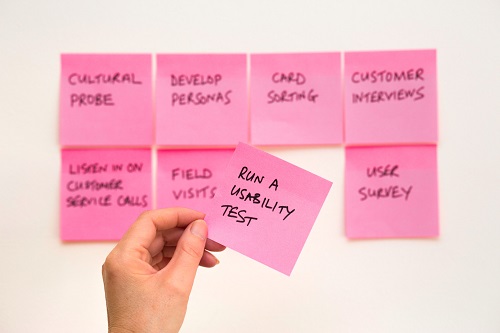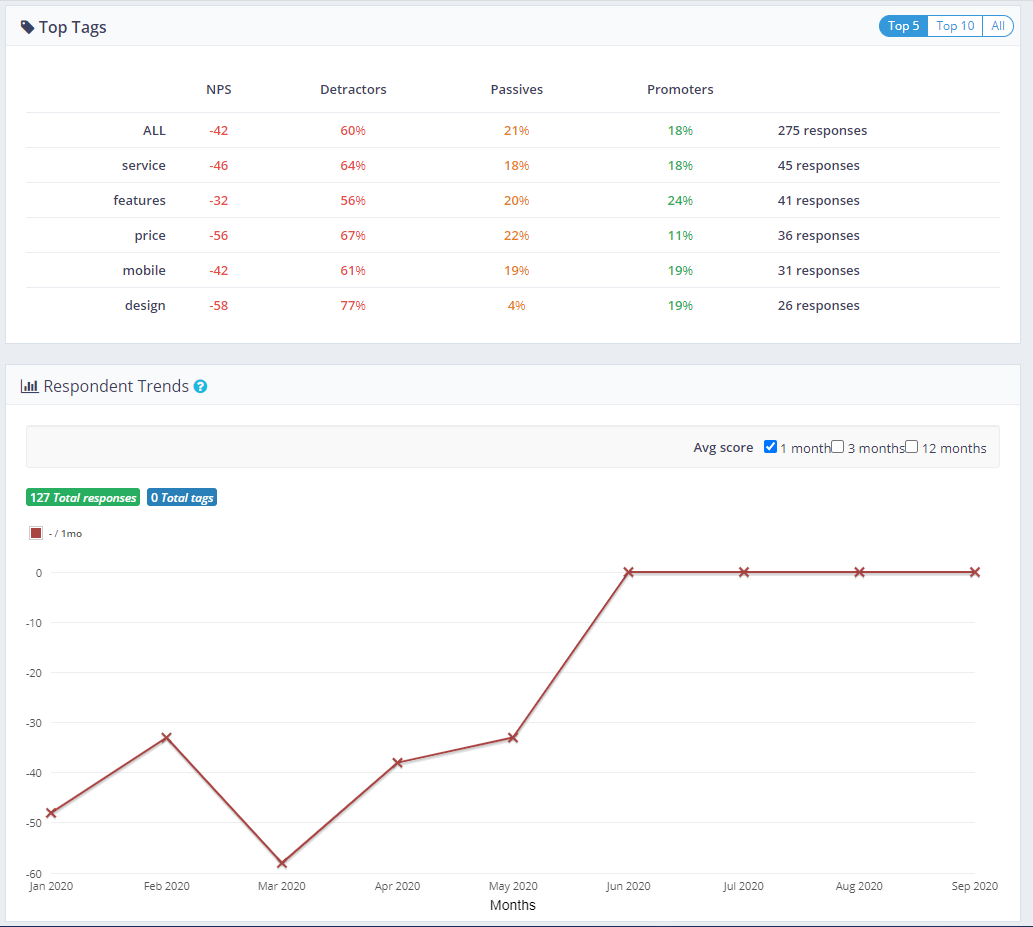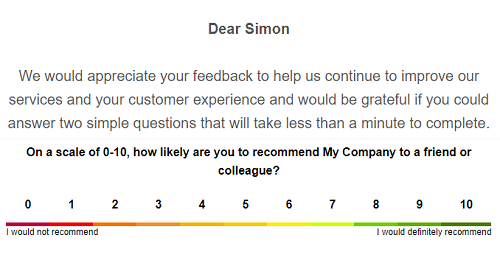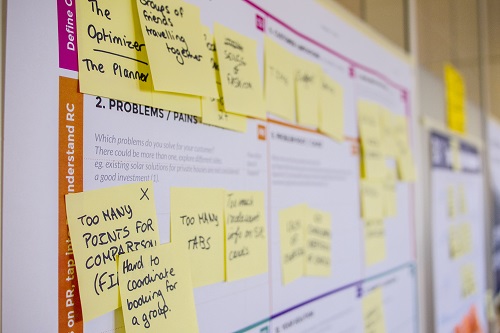Jan 2021
With more and more B2B software businesses looking to implement an agile approach to development, we wanted to look at how to ensure customer requirements and feedback form an integral part of this approach. Agile is a great methodology that's become a key part of most development teams and product managers: it's all quick reactions, often small iterative changes, based on analytics or data-driven decisions and, crucially, customer feedback. The aim is always to make small adjustments to continually focus on improving customer satisfaction.
 And to get the most from Agile methodology, it really needs to be a business-wide effort. The process is effective and simple - and always involves a lot of PostIt notes ;) - but If you simply consider it “something the devs do”, you’re missing out. This business-wide effort goes two ways: Product and development teams take advantage of insights from across the business to inform plans and roadmaps, alongside internal user testing activities. Other departments adapt applicable parts of Agile methodology (such as working in sprints) so that the whole business is aligned process-wise.
And to get the most from Agile methodology, it really needs to be a business-wide effort. The process is effective and simple - and always involves a lot of PostIt notes ;) - but If you simply consider it “something the devs do”, you’re missing out. This business-wide effort goes two ways: Product and development teams take advantage of insights from across the business to inform plans and roadmaps, alongside internal user testing activities. Other departments adapt applicable parts of Agile methodology (such as working in sprints) so that the whole business is aligned process-wise. We’ll be focusing on the first point in this article and cover some key questions:
- Why does sharing insight between departments work so well with Agile?
- What insight can you gain from different metrics and analytics?
- How can other departments contribute to better software development?
- How should you structure your internal processes to get the maximum value from these?
Let’s start with area that’s a natural partner of software development and brings a trackable metric: customer experience (CX) metrics.
Aligning product and development teams around a CX metric can be a very valuable way to bring user insight directly to software development. The product and dev teams get ‘in-their-own-words’ customer feedback and there’s a trackable metric to help managers and marketing teams see how engagement reacts to different features and campaigns. It’s obvious, but who better to help input directly to plans for product direction than those who use your software day to day?
Let’s go a little deeper into the value customer feedback metrics can provide a software business, how to track them and how to incorporate the insights they provide into your long-term vision for your product.
What Customer Metrics Do B2B Software Companies Use?
We’ve found that B2B tech companies use a range of customer metrics everyday to monitor performance and help development but there are common elements that let us divide up these metrics into three broad categories:
- Metrics which are exclusively numerical about usage of your software, typically number of visitors, time spent per session, and pages per session.
- Metrics which are driven by financial numerical, for example customer retention, spend per customer, cost of acquisition.
- Metrics which are driven by the experience of using your product, such as customer satisfaction feedback and reviews.
Whilst numerical metrics are essential and often help drive your business model (for example, if you price based on usage then pages per session would be a key metric; whilst for sales and marketing it’s the cost of acquisition and length of a customer contract that are key), these often need additional experimentation and iterative work to establish, for example, what is the right acquisition channel, or how to present information on screen to drive an increase in pages per session.
 Customer feedback metrics provide a numerical score per customer and per groups of customer and also the incredibly valuable commentary from customers themselves. If your customer tracking is working correctly, you can use one simple metric to determine the numerical score for a single customer, for a particular cohort (eg all users of a pricing plan or a feature), and then written themes that drive these numerical scores.
Customer feedback metrics provide a numerical score per customer and per groups of customer and also the incredibly valuable commentary from customers themselves. If your customer tracking is working correctly, you can use one simple metric to determine the numerical score for a single customer, for a particular cohort (eg all users of a pricing plan or a feature), and then written themes that drive these numerical scores. For example, NPS will give you a score per user (normally in the range 0 to 10), then an NPS score for a group of users (in the range of -100 to +100), and then the written themes behind these scores. It’s obviously down to the teams to use this data, but having the voice of your customers at the centre of your development roadmap will give you a huge boost in terms of understanding your product fit to the market need.
Which Customer Feedback Metrics Should We Track?
The good news is that you have plenty of options here.
You could create your own survey that targets feedback at specific areas you know you want to improve. Alternatively, you could use one or more industry-established customer experience metrics:
- Customer Effort Score (CES): you ask how easy it was to complete a particular action using your software product on a scale of one to ten (or one to five), with a box for additional comments.
- Net Promoter Score (NPS): you ask your client whether they would recommend your software to others on a scale of zero to ten, with a box for additional comments. Those who score 9 or 10 are ‘promoters’ and those who score 6 or below are ‘detractors’, with everyone in between classed as passives. You calculate your NPS score by subtracting the percentage of detractors from the percentage of promoters.
By creating your own survey, you can target questions around particular areas of your product that you’d like to improve. On the other hand, this won’t help you identify areas for improvement you hadn’t thought about.
Why Should We Ask Our Customers Open Questions?
It’s the simplicity of the open question that can give you great insight. For example, if you think search is the key feature of your software and so you ask a closed question ‘what did you think of our search function’ you will get feedback on that one feature. By asking an open question (as in NPS) about ‘why did you give this score’ the same user might write that the best/worst feature is something very different for example your responsive design. This helps you find and fix issues you didn’t realise were so important to your users. You’ll also get a numerical score alongside the comments, which you can easily track as you implement improvements and use to benchmark yourself against industry averages.
It’s also likely you’ll see a higher completion rate with these metrics, because surveys are short - each consists of just one question...and the more responses you get, the more authoritative and complete your data set will be.
CSAT vs NPS vs CES: Which One Should I Choose?
 There’s no real need to choose one of these over the others - each works well in the right context and you may well end up tracking all three at various points, depending on your long-term goals.
There’s no real need to choose one of these over the others - each works well in the right context and you may well end up tracking all three at various points, depending on your long-term goals. CES, for example, works well if you want to investigate a specific software function or user journey, but its use might be limited if you’re looking for a more general customer view of your software.
CSAT offers a good overview of customer satisfaction, and works well if you want to cast a wide net for feedback. On the other hand, you might want to compare your results with industry averages.
Ultimately, if you’re looking for the most widely-used and adopted customer satisfaction metric, then you should consider NPS. And since it focusses on recommendation rather than personal satisfaction, the bar for good scores is higher (people have to be very satisfied before recommending a product to their friends and colleagues).
Customer Metrics and Agile Development: Putting the Pieces Together
So, what specifically can you expect customer feedback metrics to offer your development team, insight-wise?
Your survey respondents might flag up:
- A different prioritisation of features to your hypothesis.
- Bugs your team have missed.
- Poor UX design.
- Ideas for new features your team might not have thought of.
- Challenges on end-to-end customer journey (eg sign-up or onboarding)
- Pricing and value
These are all invaluable in figuring out whether your product is continuing to meet product-market-fit and so meet the demands of your users.
One of the challenges is that customer requirements don’t stand still, they evolve all the time. So yes, you completed user testing pre-launch with some friendly business users – or perhaps an existing company using another of your products you have in the market. You looked at the user journeys, made your software as accessible as possible and made sure the interface was clean, attractive and easy-to-follow. However, customer need could easily have evolved over this period. In fact, as more B2B tech options become available to your potential customers, they are evolving quicker than ever. If your product tested well on launch three years ago and you haven’t issued any major updates since, how do you know that your product is still meeting customer needs?
Customer feedback fills this knowledge gap. To keep your product competitive and meeting customer need, you’ll need to identify design-based pain points quickly, fix irritating bugs and expand your functionality to meet any new market requirements faster than your immediate competitors.
What Tools Do We Need To Track Customer Feedback?
Agile is a fast, flexible development methodology. You might have settled on a weekly or even daily release process, with daily stand-ups and product managers and a dev team working to ensure that the speed of development won’t be an issue. One challenge is that if you have (rightly) put the customer at the centre of your process, make sure you have the right tools and process to ask for and analyze customer feedback in a useful timeframe.
Whilst you can use a standard email or a general purpose survey tool to send customer feedback surveys to early users and test customers, you’ll need to process the results manually, which is slow and time-consuming and involves:
- Sorting through comments, finding the ones that are relevant to product development
- Identifying any trends in comments, deciding which count as significant and which don’t
- Passing these onto the relevant person in product/development
When completed manually, these processes are lengthy and/or prone to human error. And how long do you want a poorly-designed user journey costing you customers as you try to squeeze laborious manual results processing around the rest of your responsibilities?
To make the most of customer feedback as a metric, you need to act on it fast. Specially-designed customer satisfaction software helps you do that.
How Can We Speed Up Responses To Customer Feedback?
You work in a B2B software company and know only too well the productivity benefits of automating error-prone manual processes! Features-wise, here’s the value add that customer satisfaction software offers:
- Identify themes across customer comments: find design and development-related comments quickly via automated tagging.
- Trends analysis: automatic trend identification and analysis. Are you getting more positive comments about a particular design aspect than negative? Has this changed since you implemented improvements four months ago?
- Different survey mediums: would you get more responses with in-app surveys or if you sent them via SMS? Customer satisfaction software frees you from the restraints of email to address customers where they are most likely to respond.
How Much Does Customer Satisfaction Software Cost?
Customer satisfaction software is a direct connection to your customers and offers great value and, as with any business-related investment, it’s all about the return you get for this spend.
Check out our customer satisfaction software pricing guide for more in-depth info on costs associated with different ways of keeping in touch with your customers.
What Are The Processes to Work With Agile Development?
 Asking your customers for feedback is one step but to make the most of this insight you need to analyze the results and distribute this across your teams in real-time. The processes to get this working across your teams will make a big impact on the way the data is adopted and used in development.
Asking your customers for feedback is one step but to make the most of this insight you need to analyze the results and distribute this across your teams in real-time. The processes to get this working across your teams will make a big impact on the way the data is adopted and used in development. If your customer feedback data is siloed in a particular department and others have difficulty accessing it, you’re going to struggle to use it to inform your roadmap, prioritising your backlog and through to your product marketing.
Although your product and development teams will definitely benefit from in-depth customer feedback, they’re unlikely to be collecting this data themselves - normally falls somewhere between marketing, CX and sales as a responsibility. This means that you need to plan exactly how you’ll manage the communication between different departments.
How To Avoid Data Silos and Maximise the Value Customer Feedback Offers
There are a variety of processes you could set up to make sure you’re capitalising on the value customer feedback offers your development team. Depending on the structure of your organisation, you could try:
- Directly assigning one of the seats from your customer satisfaction software to a product manager
- Implementing weekly standup meetings with representatives from CX, development/product and marketing to share insights.
- Creating a Slack channel or joint Trello board for sharing product-specific feedback, which product development teams can then add to their priorities list.
Whatever you do, avoid relying on an ‘as and when’ approach. All too often, non-urgent, ‘when you find the time’ emails get pushed further and further down priority lists until they drop off the bottom. By cementing a regular, documented process in place, your software business makes a solid commitment to seeing customer feedback as important.
Conclusion
Crucially, your product and development teams will need to agree on a way of analysing customer feedback and prioritising the actions they want to take as a result. This sort of system likely already exists for small tweaks and bug fixes - but what about larger, more strategic changes? You’ll need to agree on:
- When a trend is significant enough to be worth adding into development plans for future releases (if it wasn’t already).
- When customer feedback on a particular functionality is so significant that it warrants high priority for development.
- The impact customer feedback has on development priorities in general, in conjunction with other factors.
Your business will have its own priorities and metrics for marketing, product development and investment. Every business differs in how it prioritises a product roadmap, allocates resource, through to defining customer acquisition costs, and support. It’s all about finding the right balance for your organisation. Once you’ve found it, it will become an essential tool in growing your company to develop software products that continually iterate and react to changing customer need.
We would love to hear how you use customer feedback in your product marketing, product management or development teams, so please get in touch with your comments!
